Useful flowers in the garden to ward off pests or attract beneficial insects
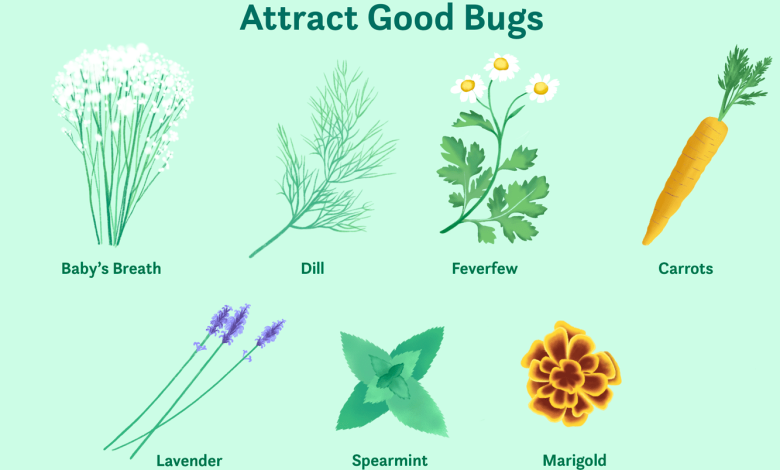
Today we will talk about the beneficial flowers for the orchard and the garden. These flowers for the garden will help you attract beneficial insects (pollinators such as bees and other auxiliary fauna) and keep pests away.
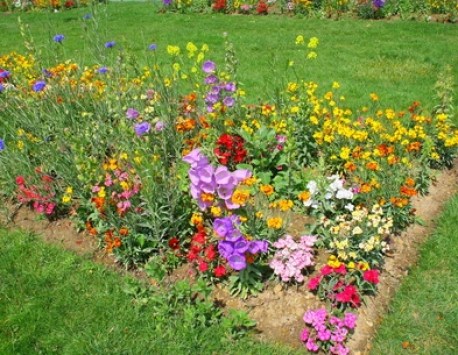
It is possible that you are cultivating a garden at home and that until now you have only limited yourself to planting and harvesting vegetables and vegetables, without stopping to think that there are useful flowers in the garden that can also be a very good option ! If this is your case, read on and turn your small garden into an even more special space thanks to these flowers in the garden.
Benefits of flowers for the garden
Flowering plants can be very good companions in your organic garden. To begin with, an orchard with flowers provides a unique aesthetic value: the shapes and colors of the flowers will give this space a more cheerful and beautiful appearance, as well as scenting the orchard or garden with a mix of very pleasant scents.
In addition to the sensory aspects, the association of flowering plants such as oleander, marigolds or chrysanthemums, with vegetables grown in the organic garden, helps us in many aspects related to the care and proper development of vegetables.
Advantages of putting flowers for the garden:
- Flowers in the garden limit weeds and keep away insects that can become pests in the garden
- Due to their allelopathic effects and the best use of the land, they attract beneficial auxiliary insects (parasites or pest predators)
- They favor pollination -because the flowers attract pollinating insects-
- They increase biodiversity, a key aspect in Organic Farming.
In addition, some of these flowering plants have petals or edible parts, so we can enjoy very special flavors by using them as condiments or main ingredients in salads, soups, sauces, tortillas… or simply as decorative elements for our dishes. You can read more about this in the post Aromatics in the garden: which ones and why.
5 Beneficial Flowers for the Orchard or Garden
The best way to keep flowers in the garden throughout the year is to use several species, the more the better, and with different flowering times. Below we will look at some of the best species of flowering plants for the vegetable garden.
1. Oleander (Nerium oleander)
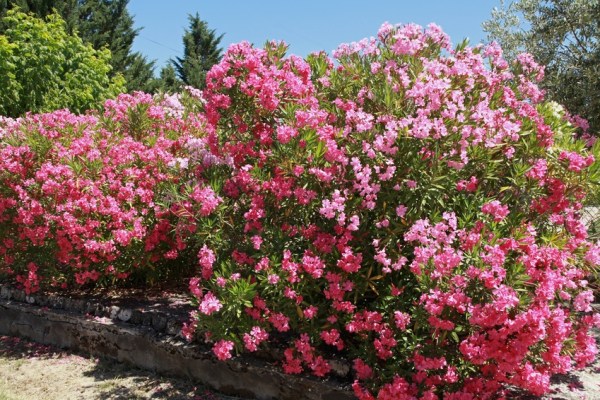
It is a shrubby plant widely used as an ornamental in gardens due to the resistance of its leaves and the prolonged white, orange or pink flowering (with flowers from spring until the beginning of the autumn-winter frosts).
You can plant it forming hedges in the orchard or garden or isolated.
Its presence in the garden is interesting because associated with this plant, the yellow aphid (Aphis neeri) lives and feeds on it, which not only does not attack the vegetables and fruit trees in the garden, but also attracts predators such as the ladybird, the lacewing or parasitoids such as wasps of the Aphidiinae family, which in this way will be close to our crops to keep pests at bay.
2. Borage (Borago officinalis)
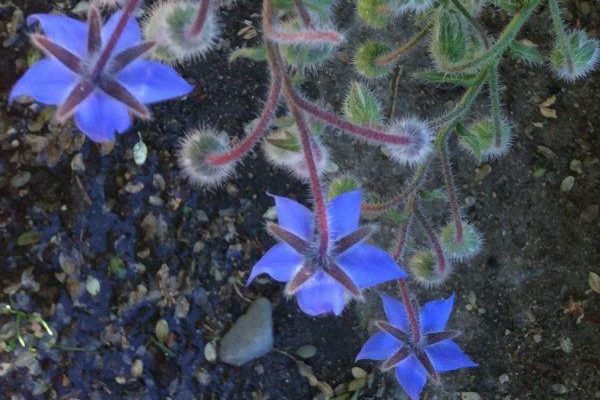
Annual herbaceous plant with blue, purple, or white flowers that last from spring to late summer.
Interesting because it does not need special care and, in addition to beautifying the garden and favoring pollination and biodiversity, it is an edible plant with diuretic, anti-stress and low-calorie properties, which provides vitamins and minerals. The leaves and stems are usually cooked like spinach in scrambled eggs, or they can also be eaten raw in salads, soups… The flowers are used in pastries or drinks.
In addition, associated with tomatoes or pumpkins enhances its flavor.
3. Calendula (Calendula officinalis)
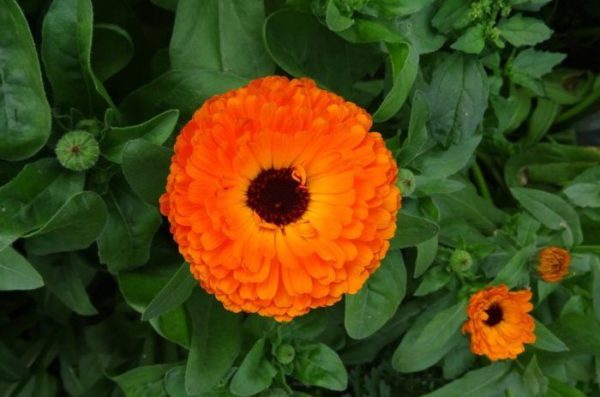
It is perennial although you can also plant it every year.
Its yellow or orange flowers attract aphid predators.
In addition to being one of the best-known useful flowers in the garden, this is another of the ornamental plants or plants with edible flowers: its flowers can be used in the kitchen as a substitute for saffron (it gives color and flavor) and also in salads.
4. Tagetes (Tagetes erecta)
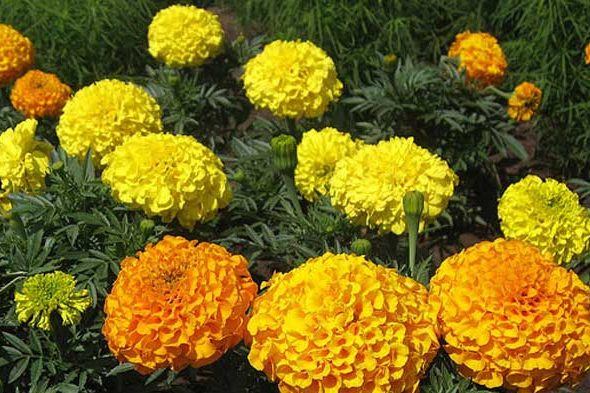
With colorful and orange annual flowers that appear from summer to autumn, the Tagete reduces up to 90% the nematodes in the soil that can cause diseases in our vegetables thanks to the toxic compounds it releases. It also helps control the infestation of aphids and other harmful insects.
You can intersperse the marigolds between the crops or plant it at one end of the bed or the cultivation table.
5. Nasturtium (Tropaeolum majus)

They are plants with bright orange flowers, and for that reason in some places this plant is known as «blood flower».
Nasturtiums are useful flowers in organic gardens that are used for biological pest control because, with their scent, they repel pests such as snails and slugs, bed bugs or aphids.
In addition, the flowers and stems of this plant can be eaten raw in salads, or cooked (in tortillas or grilled) and have a slightly spicy flavor reminiscent of watercress. The seeds are also edible, which, preserved in vinegar, are consumed as pickles, like capers.
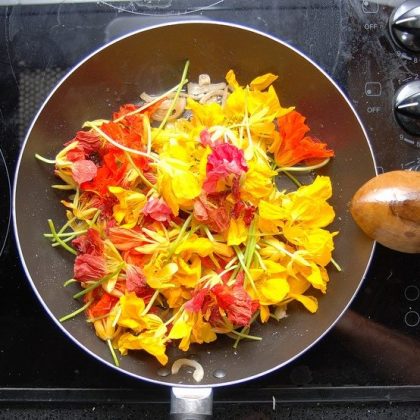
These are just a few, but we can have an endless number of flowering plants in the garden that, at a minimum, will collaborate in pollination and help us to have a more attractive orchard-garden: basil, angelicas, carnations, nasturtium, comfrey, chrysanthemums, dill, dahlias, fennel, hyssop, lavender, daisies, roses, oregano, rosemary, tansy, thyme…
Do you know other useful flowers in the organic garden? If so, tell us in the comment thread at the end of the post,
How to use garden flowers
In addition to planting or sowing flowers like the ones we have seen, we can also take advantage of all the functions of the flowers of the horticultural crops that we care for in our garden.
Edible flowers contribute to improving the aesthetics of dishes and, in addition, they provide biologically active and beneficial substances for health such as antioxidant substances, vitamins A, C, riboflavin or niacin and minerals such as calcium, phosphorus, iron or potassium.
For example, the flowers of zucchini or pumpkin, in addition to being large and showy, are edible. They are widely used in Mexican and Italian cuisine, hence they are also known by their Italian name, Zucchini. They are used to accompany or as a filling in pasta dishes (like the one in the photo on the right), or cooked in tempura, stuffed with mozzarella, vegetables…
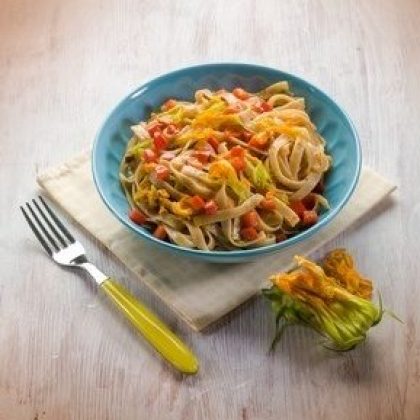
Other crops in the garden, the lilies such as onions, garlic or chives have large and showy flowers that will help us to give a more colorful touch to the garden. They are spherical inflorescences of pink, purple or whitish colors.

In addition, these flowers from the garden are also edible and can be the ideal complement in salads, where they will give a very special touch of flavor and color.
References
- Perret, S., Gacitúa, S. & Villalobos, E., 2012. Honey orchards. Sustainability for beekeeping production. Forest Institute of the Ministry of Agriculture. Government of Chile.
- Lara-Cortés, E. et al., 2013. Nutritional content, functional properties and conservation of edible flowers. Review. Latin American Archives of Nutrition, vol. 63, no. 3, p. 197-208.
- Bado, SG et al., 2016. Arthropods associated with implanted floral bands in a cherry tree crop. National Institute of Agricultural Technology (INTA, Argentina).

![Photo of Flowering Plants: [+72 Examples and Characteristics]](https://www.complete-gardening.com/wp-content/uploads/2022/08/flowering-plants-72-examples-and-characteristics-390x220.jpg)
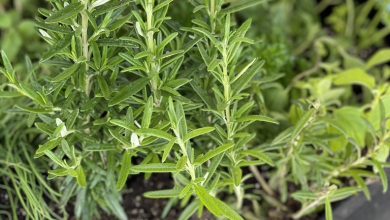
![Photo of How to Plant Chives in [13 Steps]: When, How and Where?](https://www.complete-gardening.com/wp-content/uploads/2022/08/how-to-plant-chives-in-13-steps-when-how-and-where-390x220.jpg)
![Photo of The Verbena Plant: [Planting, Care, Irrigation and Substrate]](https://www.complete-gardening.com/wp-content/uploads/2022/08/the-verbena-plant-planting-care-irrigation-and-substrate-390x220.jpg)